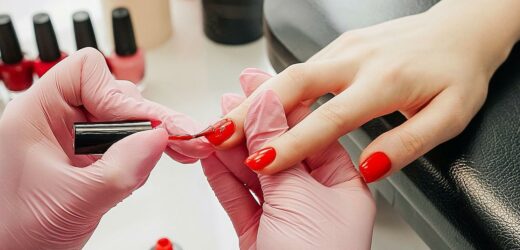I get overconfident whenever I make it home from the nail salon with my manicure intact. But just as predictably, my ego takes a hit when the polish chips as soon as I do my first load of dishes. Gel polish is my only hope.
When gel manicures first hit the salon menu they became an instant phenomenon because they're quick and as durable as car paint. The promise of a shiny, chip-free paint job that'll last for two weeks is why I've started opting for gel whenever I treat myself to a salon manicure.
But, like most good things, these glossy manicures come with a catch. Regular exposure to the UV light that's used to set the polish isn't healthy for your nails or skin, and removing the gel when you're tired of it (or it has started chipping) is a hassle that can damage your nails if it's done incorrectly.
Whether you're a diehard gel fan you're just tired of ruining your polish when you reach in your bag for your phone before even leaving the salon, see what a professional manicurist and a dermatologist have to say about the process of getting a gel manicure.
VIDEO: Here's How to Remove Gel Polish at Home
What Are the Benefits of Getting a Gel Manicure?
Anyone can get a gel manicure, whether you have natural nails (long or short), or want to get tips glued on first. Stacked up against a regular manicure, gels last longer, feel stronger, and stay shiny.
Here's how the process works: Like your run-of-the-mill mani, a gel manicure starts with cutting the nails, lightly soaking the hands, trimming the cuticles, and a thorough hand-cleaning. The polish itself is where things get different: you'll start with a base coat layer that primes your nails for the gel, which is a special kind of polish that, instead of air-drying, sets under a UV light. After each coat is painted on, you place your hand under a UV light for 30 seconds. The technician will finish things off with a glossy topcoat that's also set until a UV light.
How Long Do Gel Manicures Really Last?
Generally, a gel manicure can hold up for two to three weeks. Just like with your regular polish, how you treat your hands post-manicure and throughout those two weeks will make a big difference in staying power. "If the gels are not chipping, leaving gel polish on for two to three weeks is fine," says Olive & June founder Sarah Gibson Tuttle. "But like with all lacquer, breaks between manicures are a great way to ensure your nails stay strong and healthy."
How Much Do Gel Manicures Cost?
The price of a gel manicure can vary depending on where you live and the caliber of the salon you're visiting. Typically you can expect a gel manicure to be priced $5 to $10 more than a regular polish manicure. Because it's a process in itself, salons may charge for removal. Some salons do it free with the price of your next manicure, but it can cost up to $20.
How Do You Remove a Gel Manicure?
Taking off gel polish requires time, patience, and no picking. Whether you're getting gel taken off at the salon or DIY-ing it at home, here's how to remove a gel manicure: first, cover each nail with an acetone-soaked cotton ball, wrap some aluminum foil around each finger to hold the cotton in place, then let it sit for 10 to 15 minutes. The polish should slide off the nails without any filing or scraping. For any stubborn spots, a wooden stick can be used to gently ease it off.
Can Gel Manicures Damage Your Nails?
One of the biggest myths about gel manicures is that they're bad for your nails. In reality, how you remove gel polish can be damaging. "More often than not it's the removal process that's weakening your nails," explains Tuttle. She notes that a lot of salons rush through the removal process. "The nail bed shouldn't be filed or buffed to get your gels off," Tuttle explains, as that's how cracks and rough texture can happen. "It's not always easy to spot right away because clients often follow gels with more gels or polish."
If you're removing gels yourself, the one thing you should never do is pick or peel the polish off. It's a surefire way to cause damage, and it can mess with future manicures. "Picking off your gels removes layers of your nail along with it. Plus, it makes it harder for future polish and gel to stay on," says Tuttle.
Tuttle recommends applying cuticle oil between appointments to keep the area hydrated and healthy. This will not only protect the skin around your nails but your actual nail beds, too.
Are UV Lights Really Dangerous?
The major criticism of gel manicures is that the UV lights you put your hands under to set the gel polish can cause premature aging and put you at a higher risk for skin cancer. It turns out there is truth to this. "The ultraviolet light emitted from these dryers is actually much stronger than what you would get from sun exposure," says Joshua Zeichner, M.D., director of cosmetic and clinical research in dermatology at Mount Sinai Hospital in New York City. "UVA light is responsible for both skin aging and the development of skin cancers. If you are going to get gel manicures, it is important to apply sunscreen to your hands for protection."
He suggests looking for a product that's labeled as "broad spectrum," which will protect you from this kind of light.
Source: Read Full Article


